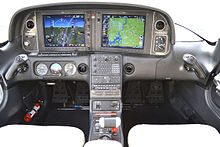Electronic Flight Instrument System
An Electronic Flight Instrument System ( EFIS ; German Electronic Flight Instrument System ) is a group of configurable multi-function displays (MFD) in the cockpit of an aircraft , on which aircraft and sensor data can be displayed. The EFIS is also known colloquially as the “glass cockpit”. In contrast, older cockpits are jokingly referred to as "watch stores" because of the numerous pointer instruments.
need
The need for displays in the cockpit increased significantly with the installation of more and more sensors and navigation systems such as the flight management system . At the same time, there was a need to improve this interface between man and machine .
When equipped with EFIS , the pilots can see all the information they need for an aircraft on several color screens . This is often combined with a screen for the engine displays, for warning messages and for checklists, for example with the EICAS or the ECAM .
Depending on the displays shown, context-related settings can be made using the control buttons on the side of the displays. This increases the clarity in a cockpit significantly.
For security reasons, not all systems have been completely replaced by screens. Some basic devices must still be available without computer assistance, such as an emergency compass and an artificial horizon . Further security aspects were set up for the screen control: If an individual screen no longer receives power, it goes black; however, if no signal is available from the computer, a large red cross appears to indicate to the pilot that he has to switch to another computer.
Due to the high cost, glass cockpits were initially only used in commercial aircraft. In the private machine sector, glass cockpits have recently been offered by some manufacturers. Well-known examples are the Cirrus Design Corporation for the Cirrus SR22 , Cessna for the Skyhawk / Skylane , Columbia Aircraft Corporation for the Columbia 400 or Diamond Aircrafts for the DA40 / DA42 . The space shuttle of NASA were also equipped with a glass cockpit.
Software development must be done in accordance with the DO-178B standard in order to receive certification for aviation use from the FAA .
System structure
Primary Flight Display (PFD)

The pilots are shown the most important flight data on the PFD: the position in space ( artificial horizon ) with the flight director , the flight speed, the flight altitude and the rate of climb or descent. You can also see the operating modes of the autopilot here. Additional displays are added depending on the model.
The navigation data is displayed on the ND: the heading , the VOR or ADF radio beacons , the flight route from the flight management system , traffic information from the TCAS and the image from the weather radar . Here, too, other displays depend on the model.
Display Management Computer (DMC)
This is a component (engl. Unit ), which processes the symbols and data for the displays for the screens. Its function is similar to that of a graphics card.



